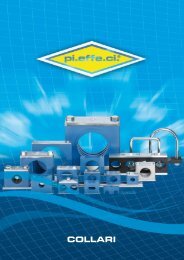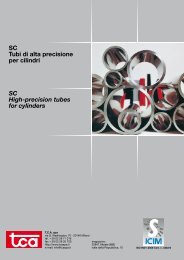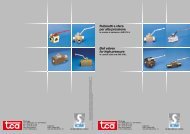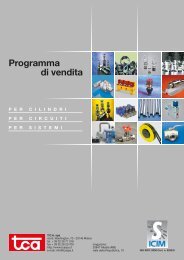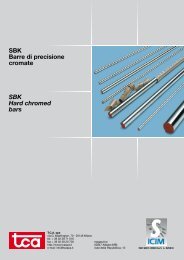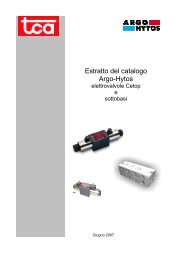- Page 1:
Product Manual 2007Hydraulic Screw-
- Page 4 and 5:
Hydraulic Integrated CircuitsScrew-
- Page 6 and 7:
INTRODUCTIONQUICK SELECTION GUIDERE
- Page 8 and 9:
MATERIALSCartridge bodies are manuf
- Page 10 and 11:
QUICK SELECTION GUIDESECTION 2 - RE
- Page 12 and 13:
QUICK SELECTION GUIDESECTION 4 - SE
- Page 14 and 15:
QUICK SELECTION GUIDESECTION 6 - MO
- Page 16 and 17:
QUICK SELECTION GUIDESECTION 6 - MO
- Page 18 and 19:
QUICK SELECTION GUIDESECTION 7 - CH
- Page 20 and 21:
QUICK SELECTION GUIDESECTION 9 - FL
- Page 22 and 23:
QUICK SELECTION GUIDESECTION 11 - D
- Page 24 and 25:
QUICK SELECTION GUIDESECTION 11 - P
- Page 26 and 27:
QUICK SELECTION GUIDESECTION 13 - S
- Page 28 and 29:
QUICK SELECTION GUIDESECTION 16 - H
- Page 30 and 31:
SECTION SERIES APPLICATION RANGE PA
- Page 32 and 33:
Figure 1. 1DR30 Direct acting poppe
- Page 34 and 35:
Figure 4. 1GR60 Direct acting spool
- Page 36 and 37:
CARTRIDGE ONLYCOMPLETE VALVE3/8’
- Page 38 and 39:
CARTRIDGE ONLYCOMPLETE VALVE1/2”
- Page 40 and 41:
CARTRIDGE ONLYCOMPLETE VALVE1/2”
- Page 42 and 43:
CARTRIDGE ONLYBASIC CODE: 1UAR100HE
- Page 44 and 45:
PRESSURE DROP1DR21DR30PRESSURE-BARF
- Page 46 and 47:
PRESSURE DROPCARTRIDGE ONLY03FLOW-U
- Page 48 and 49:
CARTRIDGE ONLYCOMPLETE VALVE3/8”
- Page 50 and 51:
CARTRIDGE ONLYBASIC CODE: 1GR30 OR
- Page 52 and 53:
CARTRIDGE ONLYCOMPLETE VALVE3/4’
- Page 54 and 55:
CARTRIDGE ONLYBASIC CODE: 1LR30070.
- Page 56 and 57:
040035010FLOW-US GPM203040PRESSURE
- Page 58 and 59:
PRESSURE DROPFLOW-US GPM0 10 20 30
- Page 60 and 61:
PRESSURE DROPPRESSURE-BAR0 10400350
- Page 62 and 63:
PRESSURE DROPFLOW-US GPMFLOW-US GPM
- Page 64 and 65:
PRESSURE DROP025FLOW-US GPM50751000
- Page 66 and 67:
TYPICAL CIRCUIT EXAMPLES1CLLRDUAL R
- Page 68 and 69:
COMPLETE VALVEBASIC CODE: 1 DDR35Bo
- Page 70 and 71:
CARTRIDGE ONLYBASIC CODE: 1CLLR50SC
- Page 72 and 73:
CARTRIDGE ONLYBASIC CODE: 1CLLR100C
- Page 74 and 75:
COMPLETE VALVEBASIC CODE: 1LLR150Su
- Page 76 and 77:
COMPLETE VALVEBASIC CODE: 1LLR350Su
- Page 78 and 79:
COMPLETE VALVEBASIC CODE: 1DDRC35Su
- Page 80 and 81:
COMPLETE VALVEBASIC CODE: 1LLRC75Su
- Page 82 and 83:
COMPLETE VALVEBASIC CODE: 1VRC250Su
- Page 84 and 85:
TYPICAL CIRCUIT EXAMPLES1PS/1DS1PS/
- Page 86 and 87:
With a direct acting sequence the g
- Page 88 and 89:
Figure 8. Pressure Compensated Flow
- Page 90 and 91:
CARTRIDGE ONLYCOMPLETE VALVE3/8”
- Page 92 and 93:
CARTRIDGE ONLYBASIC CODE:71.0 39.0
- Page 94 and 95:
CARTRIDGE ONLYCOMPLETE VALVE3/8”
- Page 96 and 97:
CARTRIDGE ONLYBASIC CODE:39.0 MAX71
- Page 98 and 99:
CARTRIDGE ONLYBASIC CODE:1PS200HEX
- Page 100 and 101:
PRESSURE DROP0FLOW - US GPM246802.5
- Page 102 and 103:
PRESSURE DROP040010FLOW-US GPM20304
- Page 104 and 105:
CARTRIDGE ONLYBASIC CODE: 1UPS10039
- Page 106 and 107:
TYPICAL CIRCUIT EXAMPLES1PD1PA5BRAK
- Page 108 and 109:
PRESSURE DROPCARTRIDGE ONLYPRESSURE
- Page 110 and 111:
PRESSURE DROPCARTRIDGE ONLYBASIC CO
- Page 112 and 113:
CARTRIDGE ONLYCOMPLETE VALVE3/8”
- Page 114 and 115:
CARTRIDGE ONLYBASIC CODE:1PA10039.0
- Page 116 and 117:
CARTRIDGE ONLYBASIC CODE:1PA200HEX
- Page 118 and 119:
CARTRIDGE ONLYBasic Code: 1PAA60HEX
- Page 120 and 121:
SECTION SERIES APPLICATION RANGE PA
- Page 122 and 123:
egin moving at the flow at which th
- Page 124 and 125:
The successful application of motio
- Page 126 and 127:
PRESSURE DROP2.5:1 & 5:1 version10:
- Page 128 and 129:
PRESSURE DROP50FLOW-US GPM0 2.5 5 7
- Page 130 and 131:
PRESSURE DROPFLOW-US GPM0 2.5 5 7.5
- Page 132 and 133:
PRESSURE DROPFLOW-US GPM0 2.5 5 7.5
- Page 134 and 135:
PRESSURE DROP02.5FLOW-US GPM57.5101
- Page 136 and 137:
PRESSURE DROP02.5FLOW-US GPM57.5101
- Page 138 and 139:
NOTES6
- Page 140 and 141:
PRESSURE-BARPRESSURE DROP4:1 VERSIO
- Page 142 and 143:
PRESSURE DROPFLOW-US GPM0 6.5 13 19
- Page 144 and 145:
PRESSURE DROPCARTRIDGE ONLY016FLOW-
- Page 146 and 147:
PRESSURE DROPFLOW-US GPM06.51319.5
- Page 148 and 149:
PRESSURE DROPCARTRIDGE ONLYFLOW-US
- Page 150 and 151:
PRESSURE DROPFLOW-US GPM0 5 10 1520
- Page 152 and 153:
PRESSURE DROPCARTRIDGE ONLY160FLOW-
- Page 154 and 155:
PRESSURE DROPCARTRIDGE ONLY0FLOW-US
- Page 156 and 157:
PRESSURE DROPFLOW-US GPM082440 5672
- Page 158 and 159:
PRESSURE DROP08FLOW - US GPM2440 56
- Page 160 and 161:
NOTES6
- Page 162 and 163:
PRESSURE DROPPRESSURE-BARFLOW-US GP
- Page 164 and 165:
PRESSURE DROPCARTRIDGE ONLYFLOW-US
- Page 166 and 167:
PRESSURE DROPCARTRIDGE ONLYFLOW-US
- Page 168 and 169:
PRESSURE DROPFLOW-US GPM0 25 50 751
- Page 170 and 171:
PRESSURE DROPCARTRIDGE ONLYBASIC CO
- Page 172 and 173:
PRESSURE DROPFLOW-US GPM0 25 50 752
- Page 174 and 175:
PRESSURE DROPFLOW-US GPM240 25 5075
- Page 176 and 177:
NOTES6
- Page 178 and 179:
PRESSURE DROP2.5:1 & 5:1 version10:
- Page 180 and 181:
PRESSURE DROP16FLOW-US GPM0 6.5 131
- Page 182 and 183:
PRESSURE DROPCOMPLETE VALVE1” POR
- Page 184 and 185:
PRESSURE DROPCOMPLETE VALVE3/8” P
- Page 186 and 187:
PRESSURE DROPCOMPLETE VALVE1” POR
- Page 188 and 189:
PRESSURE DROP02.5 5FLOW-US GPM7.5 1
- Page 190 and 191:
PRESSURE DROPFLOW-US GPM0 6.5 13 19
- Page 192 and 193:
PRESSURE DROPCOMPLETE VALVE1” POR
- Page 194 and 195:
LOAD CONTROL / HOLDING VALVESHOSE B
- Page 196 and 197:
Figure 2. Load HoldingWhen the cont
- Page 198 and 199:
COMPLETE VALVEBASIC CODE:1CEBL256FL
- Page 200 and 201:
1.61.61.6COMPLETE VALVEBASIC CODE:1
- Page 202 and 203:
COMPLETE VALVEBASIC CODE:1CEBL556FL
- Page 204 and 205:
COMPLETE VALVEBASIC CODE:1CEBL31LIN
- Page 206 and 207:
COMPLETE VALVEBASIC CODE:1CEBL31FLA
- Page 208 and 209:
COMPLETE VALVEBASIC CODE:1CEBL31LIN
- Page 210 and 211:
COMPLETE VALVEBASIC CODE:1CEBL91LIN
- Page 212 and 213:
COMPLETE VALVEBASIC CODE:1CEBL151LI
- Page 214 and 215:
COMPLETE VALVEBASIC CODE:1CEBL15376
- Page 216 and 217:
TYPICAL CIRCUIT EXAMPLESCOOLER BYPA
- Page 218 and 219:
PRESSURE DROPFPR 3/4” FPR 1”PRE
- Page 220 and 221:
PRESSURE DROP10FLOW - US GPM5 10 15
- Page 222 and 223: CARTRIDGE ONLY COMPLETE VALVE 1/4
- Page 224 and 225: CARTRIDGE ONLY COMPLETE VALVE 1/4
- Page 226 and 227: CARTRIDGE ONLYBASIC CODE: 3CP227.00
- Page 228 and 229: CARTRIDGE ONLYSINGLE VALVE3/8” 1/
- Page 230 and 231: CARTRIDGE ONLYSINGLE VALVE1/2” PO
- Page 232 and 233: PRESSURE DROPCARTRIDGE ONLYBASIC CO
- Page 234 and 235: CARTRIDGE ONLYBASIC CODE: 4CK12055.
- Page 236 and 237: CARTRIDGE ONLYSINGLE VALVE1 1/4”
- Page 238 and 239: COMPLETE VALVEBASIC CODE: 4CK356THR
- Page 240 and 241: PRESSURE DROPSINGLE VALVE3/8” 1/2
- Page 242 and 243: PRESSURE DROP02.5FLOW - US GPM5 7.5
- Page 244 and 245: COMPLETE VALVEBASIC CODE: 4KD251/4
- Page 246 and 247: CARTRIDGE ONLYBASIC CODE: 5CK3039.5
- Page 248 and 249: TYPICAL CIRCUIT EXAMPLES2N2R2N2NSPE
- Page 250 and 251: CARTRIDGE ONLYBASIC CODE: 2CN20HEX
- Page 252 and 253: CARTRIDGE ONLYBASIC CODE: 2 CR30HEX
- Page 254 and 255: CARTRIDGE ONLYBASIC CODE: 2CR804.0
- Page 256 and 257: TYPICAL CIRCUIT EXAMPLES2FP2FP2FBAR
- Page 258 and 259: PERFORMANCECARTRIDGE ONLYLOAD PRESS
- Page 260 and 261: PERFORMANCECARTRIDGE ONLYLOAD PRESS
- Page 262 and 263: PERFORMANCECARTRIDGE ONLYBASIC CODE
- Page 264 and 265: REGULATED FLOW-LITRES/MINLOAD PRESS
- Page 266 and 267: PERFORMANCEREGULATED FLOW-LITRES/MI
- Page 268 and 269: REGULATED FLOW-LITRES/MIN0 700 1400
- Page 270 and 271: REGULATED FLOW-LITRES/MIN0 700 1400
- Page 274 and 275: This type of flow regulator lends i
- Page 276 and 277: PERFORMANCEREGULATED FLOW-LITRES/MI
- Page 278 and 279: 300LOAD PRESSURE-PSIBYPASS HIGHER T
- Page 280 and 281: TYPICAL CIRCUIT EXAMPLES10CYLINDER
- Page 282 and 283: eventually restricting the outlet o
- Page 284 and 285: There are a number of different des
- Page 286 and 287: PRESSURE DROPCARTRIDGE ONLYPRESSURE
- Page 288 and 289: PRESSURE DROPCARTRIDGE ONLYFLOW-US
- Page 290 and 291: PRESSURE DROPCARTRIDGE ONLY05FLOW-U
- Page 292 and 293: PRESSURE DROPCARTRIDGE ONLYPRESSURE
- Page 294 and 295: CIRCUIT SERIES APPLICATION RANGE PA
- Page 296 and 297: C13 CoilsC16 Coils49.047.838,150.02
- Page 298 and 299: S5 Series- consult factory for avai
- Page 300 and 301: CARTRIDGE ONLYBASIC CODE: S201 (Nor
- Page 302 and 303: CARTRIDGE ONLYBASIC CODE: S501 (Nor
- Page 304 and 305: CARTRIDGE ONLYCOMPLETE VALVEBASIC C
- Page 306 and 307: CARTRIDGE ONLYBASIC CODE: S901 (Nor
- Page 308 and 309: CARTRIDGE ONLYBASIC CODE:S600 (Norm
- Page 310 and 311: PRESSURE DROPFLOW-US GPM0 255025752
- Page 312 and 313: CARTRIDGE ONLYBASIC CODE: SX203 (No
- Page 314 and 315: CARTRIDGE ONLYBASIC CODE: S205 (Nor
- Page 316 and 317: CARTRIDGE ONLYBASIC CODE: S20748.00
- Page 318 and 319: CARTRIDGE ONLYBASIC CODE: S607 Popp
- Page 320 and 321: PERFORMANCES210 (Normally open)PERF
- Page 322 and 323:
PERFORMANCEPERFORMANCES510 / S511 (
- Page 324 and 325:
PERFORMANCEFLOW (US GPM)2500.125 0.
- Page 326 and 327:
PERFORMANCEPERFORMANCES217 (standar
- Page 328 and 329:
PERFORMANCEFLOW (US GPM)2501 2 3 45
- Page 330 and 331:
CARTRIDGE ONLYCOMPLETE VALVE3/4”
- Page 332 and 333:
PERFORMANCES220 (Standard valve)WOR
- Page 334 and 335:
PERFORMANCESELECTOR MODEPERFORMANCE
- Page 336 and 337:
PERFORMANCES221 (Standard valve)PER
- Page 338 and 339:
PERFORMANCESELECTOR MODEWORKING PRE
- Page 340 and 341:
PERFORMANCEFLOW (US GPM)WORKING PRE
- Page 342 and 343:
PERFORMANCES525 (Standard valve)WOR
- Page 344 and 345:
PERFORMANCEWORKING PRESSURE (BAR)25
- Page 346 and 347:
PERFORMANCEFLOW (US GPM)1250.5 1 1.
- Page 348 and 349:
PERFORMANCE250FLOW (US GPM)1.25 2.5
- Page 350 and 351:
PERFORMANCEFLOW (US GPM)2500.5 1 1.
- Page 352 and 353:
PERFORMANCEWORKING PRESSURE (BAR)25
- Page 354 and 355:
PERFORMANCEFLOW (US GPM)WORKING PRE
- Page 356 and 357:
PERFORMANCEPERFORMANCES242 (Standar
- Page 358 and 359:
PERFORMANCEFLOW (US GPM)2501.3 2.6
- Page 360 and 361:
PERFORMANCEFLOW (US GPM)2500.5 1 1.
- Page 362 and 363:
PERFORMANCEPERFORMANCEFLOWING BACK
- Page 364 and 365:
PERFORMANCEFLOW (US GPM)2500.5 1 1.
- Page 366 and 367:
PERFORMANCEPERFORMANCEFLOWING BACK
- Page 368 and 369:
PERFORMANCEFLOW (US GPM)2500.5 1 1.
- Page 370 and 371:
PERFORMANCEPERFORMANCEFLOWING BACK
- Page 372 and 373:
PERFORMANCEFLOW (US GPM)2500.5 1 1.
- Page 374 and 375:
PERFORMANCEFLOW (US GPM)2501.3 2.6
- Page 376 and 377:
PERFORMANCE250FLOW (US GPM)0.5 1 1.
- Page 378 and 379:
PERFORMANCEFLOW (US GPM)2801.3 2.6
- Page 380 and 381:
PERFORMANCEPRESSURE (BAR)3503002501
- Page 382 and 383:
PERFORMANCECARTRIDGE ONLYBASIC CODE
- Page 384 and 385:
7.00PERFORMANCEFLOW (LITRES/MIN)359
- Page 386 and 387:
TYPICAL CIRCUIT EXAMPLESBRAKEVALVE1
- Page 388 and 389:
PERFORMANCE CURVECARTRIDGE ONLYSYST
- Page 390 and 391:
PERFORMANCE CURVETYPICAL VALVE PERF
- Page 392 and 393:
COMPLETE VALVEBASIC CODE: 1UL255Sub
- Page 394 and 395:
TYPICAL CIRCUIT EXAMPLES1SH1SB1RDSR
- Page 396 and 397:
PRESSURE DROPFLOW-US GPM0 1 2 34 56
- Page 398 and 399:
CARTRIDGE ONLYBASIC CODE: 1SH2062.0
- Page 400 and 401:
COMPLETE VALVEBASIC CODE: 1SH363/8
- Page 402 and 403:
CARTRIDGE ONLYBASIC CODE: 1SB1051.5
- Page 404 and 405:
CARTRIDGE ONLYBASIC CODE: 1SB202HEX
- Page 406 and 407:
CARTRIDGE ONLYBASIC CODE: 1SB304HEX
- Page 408 and 409:
PRESSURE DROPCARTRIDGE ONLY01.25FLO
- Page 410 and 411:
PRESSURE DROPFLOW-US GPM0 2 4106814
- Page 412 and 413:
PRESSURE DROPCARTRIDGE ONLYBASIC CO
- Page 414 and 415:
PRESSURE DROPCARTRIDGE ONLYBASIC CO
- Page 416 and 417:
CARTRIDGE ONLYBASIC CODE: 1HSH2054.
- Page 418 and 419:
CARTRIDGE ONLYBASIC CODE: 1HSH70190
- Page 420 and 421:
COMPLETE VALVE1/2” PORTS1HSH20-*S
- Page 422 and 423:
PRESSURE DROPCARTRIDGE ONLYVENTED P
- Page 424 and 425:
PRESSURE DROPVENTED PRESSURE DROPCA
- Page 426 and 427:
PRESSURE DROPFREE FLOW 1-2CARTRIDGE
- Page 428 and 429:
PRESSURE DROPCARTRIDGE ONLYVENTED P
- Page 430 and 431:
TYPICAL CIRCUIT EXAMPLESABABPTPTPPT
- Page 432 and 433:
COMPLETE VALVEBASIC CODE: 03ACE* Ov
- Page 434 and 435:
COMPLETE VALVEBASIC CODE: 05ACE* Ov
- Page 436 and 437:
COMPLETE VALVEBASIC CODE: 03ACK Che
- Page 438 and 439:
COMPLETE VALVEBASIC CODE: 05ACK Che
- Page 440 and 441:
NOTES14
- Page 442 and 443:
TYPICAL CIRCUIT EXAMPLESDUAL RELIEF
- Page 444 and 445:
COMPLETE VALVEBASIC CODE:Sub-assemb
- Page 446 and 447:
COMPLETE VALVEBASIC CODE:Sub-assemb
- Page 448 and 449:
PRESSURE DROP2.5:1 & 5:1 VERSION 10
- Page 450 and 451:
PRESSURE DROP4:1 VERSION 8:1 VERSIO
- Page 452 and 453:
PRESSURE DROP501ce302.5:1 & 5:1 VER
- Page 454 and 455:
PRESSURE DROP4:1 VERSION 8:1 VERSIO
- Page 456 and 457:
CIRCUIT SERIES APPLICATION RANGEPAG
- Page 458 and 459:
HYDRAULIC INTEGRATED CIRCUITS1T16 P
- Page 460 and 461:
VALVE CAVITY PAGE NUMBER2CFD150 A19
- Page 462 and 463:
CARTRIDGE CAVITIESCAVITY A881CAVITY
- Page 464 and 465:
CARTRIDGE CAVITIESCAVITY A3145CAVIT
- Page 466 and 467:
CARTRIDGE CAVITIESCAVITY A6610CAVIT
- Page 468 and 469:
CARTRIDGE CAVITIESCAVITY A12088CAVI
- Page 470 and 471:
CARTRIDGE CAVITIESCAVITY A13245CAVI
- Page 472 and 473:
CARTRIDGE CAVITIESCAVITY A20530CAVI
- Page 474 and 475:
CARTRIDGE CAVITIESISO STANDARDCAVIT
- Page 476 and 477:
PORTSBSP, SAE, BSP WITH ‘O’-RIN
- Page 478 and 479:
SAE MOUNTING PATTERN3000 psi (210 b
- Page 480 and 481:
Part No. Page Part No. Page Part No
- Page 482 and 483:
Part No. Page Part No. Page Part No
- Page 484 and 485:
Part No. Page Part No. Page Part No
- Page 486 and 487:
NORTH AMERICAN DISTRIBUTORSFor an u





